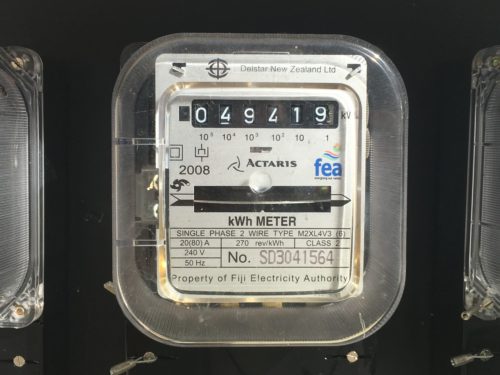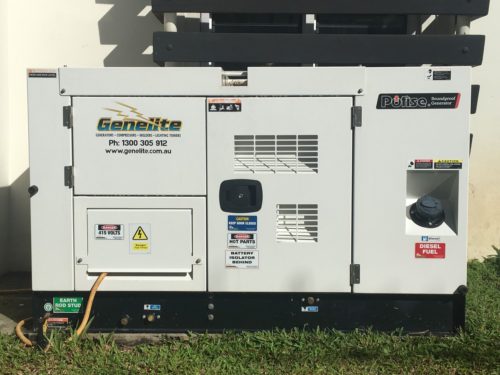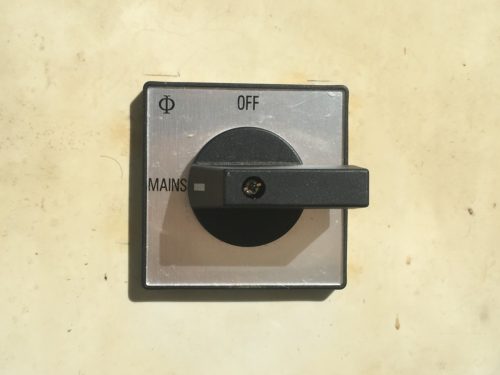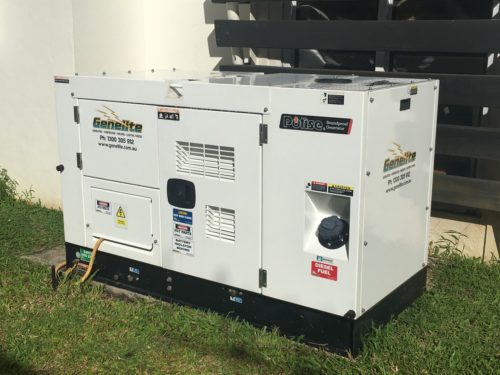The only things I used to know about generators were that my Dad had one and that they had something to do with KVA, a term he’d often prattle on about. I would have never guessed that in two years, I’d find myself not only the proud owner of one that is roughly half the size of a small car, but also, that I’d find myself writing about them.
I’m here today to give you a three minute degree in generators, An Island Idiot’s Guide, if you will, to one of the most important pieces of machinery one can own when living on an island where power outages are as common as baked dinners. A place where you better save your computer work regularly to avoid tears, and where you learn quickly just how long your fridge and freezer will remain at a food safe temperature before you either A) need to start having a massive cook-up or B) risk throwing out the entire contents of both.
For the record, it’s roughly 6-8 hours for your fridge and 10-12 hours for your freezer. Keep both closed to maintain the best conditions. If you must open either, be quick, get in, get out. Kids are banned; all access via one person with military precision is vital.
Lesson 1: Why Do I Need A Generator, You Ask?
Intermittent power outages are a breath of fresh air… until they’re not. When you’re an island newbie and they first occur, you might even find it refreshing to get back to basics having not realised just how much of your life is dependent on electricity. It’s an opportunity to do all the things you have been putting off for ages – to pull the circuit breaker of sorts. It can be frustrating to feel like you’re “wasting the day,” but are you really? Given that the outages are totally beyond your control, I learned early on that it’s better to just go with it and try to make the most of the time. After all, who gets a forced stoppage in their workday? Plenty of office bound workers would kill for this. The closest they come is perhaps a biannual fire alarm.
It’s when power outages happen multiple days in a week and for multiple weeks in a row that the previous paragraph can go to hell, especially when you’re trying to run a business from home. Power outages in winter are fine as we didn’t have the air-con on anyway, but summer is a different story. Never mind the fridge and freezer – what about me? The human literally melting into a puddle on the floor?
Sleeping is a whole other issue. When you lived in Suburbia, you probably never stopped to think about what it’s like to sleep in 28°C heat with 90% humidity with no fan. That’s right – no power doesn’t just mean no air-con, it means literally no fan. Our poor precious dog looked at me as if to say, What’s going on Mum? These tiles aren’t what they used to be, and I’m not even on the bed.

Lesson 2: How Big Is Big Enough?
In less than two years on this rock, we’ve had three of the bad boys.
We started with a small 2 KVA, which is suitable to run the fridge and freezer while charging an iPhone and that’s about it. The Survival Generator, if you will. Running time is approximately 4-6hrs, our runs on unleaded fuel. It is also perfect to run my Mac and a fan.
Quickly realizing outages were here to stay, we knew another purchase had to be made. Temporarily pulling the circuit breaker was great, but not quite conducive to productivity given that I work from home. Welcome Mr. 5 KVA and a entire day of REWIRING and balancing the house to ensure our new 5 KVA would run on one circuit and not be overloaded.
5KVA will see most household living fairly comfortably. Basic living, running appliances like TVs and computers with lighting during the day and night. And when everything is off with the exception of the fridge and freezer, you might be lucky enough to be able to run your air-conditioning at night depending on the capacity… maybe. Mr. 5 KVA needs to be re-fueled every 6 hours and I’m sure people across the valley can hear it running. Less than ideal, but still something we were fortunate to have.
Then, at the beginning of 2016, Fiji experienced its worst cyclone in their history, the second worst in all of history. Followed by another smaller cyclone and a flood. We had no power for nearly three weeks straight and countless outages for the following two months. There is a very big difference between “Yay, the power is out, let’s go for a swim” and “It’s 35°C, 98% humidity, and my food is done for” kind of outage.
Fiji is our home and we’d love to stay for as long as they would like to have us. We made the decision that we wanted to live as normally as possible, to get back to normal. If we could do this, we could then help others. Without sleep and food we be no good to anybody. So it was time to invest in the Grand Poobah of generators: Mrs. 12 KVA.

Now let’s get to business on how to make this happen, shall we?
Lesson 3: Muffle That Generator
If you’re building a house, put the switches and other technical crap in a brick shed on the edge of your property, away from your bedroom and neighbour’s house. Unless, of course, they drive you nuts and you don’t mind starting World War III.
Running a generator during the day and generally getting on with things can be a little (read: fair bit) noisy, but will be more than enough to make life comfortable during intermittent outages and if you can shield everyone from the noise as best you can, it’s well worth it.
Lesson 4: Three Way Switches Are Where It’s At
Be mindful of the fact that you are playing with real electricity – the very live and very dangerous, it-can-kill-you type of electricity. There is no room for error. Literally.
If you can, I’d suggest a three way switch (see real-life photo below).

What is a three way switch, you ask? It’s a switch that’s added to your power box that allows you to turn mains power off before turning the generator on, plugging it in, and then switching the switch to generator.
Sounds straight forward enough, right? It is. But once you start the generator, the extension cord coming out of is live. If you plug it into the house and the power comes back on and you don’t know it – BOOM. You’ll be toast. At the very least, your appliances will be. Receiving that spike of power will surely be enough to nuke everything you own, ensuring you’ll definitely get no work done or be watching any TV for awhile. So, three way switch. Agreed?
Lesson 5: Leave It To The Professionals, Will Ya?
Consult a qualified electrician for installation. Full stop, amen. We’ve already had the chat about electricity killing people, remember?
As per everything on island, we had issues with the house and the generator not liking each other. I can’t even explain to you what the issue was, I only know it took about a dozen visits from our amazing electrician and a few hundred dollars worth of phone calls back to Australia to get it sorted so we didn’t nuke everything in the house.
Lesson 6: Let’s Get It Started!
To start your generator, this is it simply:
Switch three way switch to OFF.
Turn battery on generator ON.
Turn generator key or keys to ON.
Wait for generator to turn on and warm up, approximately 2 minutes.
Switch three way switch to GENERATOR.
Go inside and check everything is working.
Enjoy your power and wait for your neighbour to text you to let you know the power is back on. (If the main switch is on GENERATOR, the house literally has no way of ever knowing if the mains power is back on.)
Lesson 7: Keep Her Fueled, Baby
Do not let a diesel generator run out of fuel. This will result in a mission task of bleeding the lines and to this day, I’m not even sure what that means because – repeat after me – I will monitor the fuel, I will monitor the fuel, I will monitor the fuel…
An important part of this step is to set your future powerless self up for success: always make sure the diesel drums are refilled after each use.

Lesson 8: Pump It!
A plastic battery-operated diesel pump works wonders when your arms look like mine. I’m all good to lift the 20kg drum of diesel, but funnelling it from one drum to the pouring drum via a filter to remove the debris that’s commonplace in crappy island fuel is a bit of a juggling act on my own. The intake for diesel is on the side of our generator which makes it quite possibly the most annoying and back-breaking position ever!
This lesson also includes an oath to be taken by the husband or boyfriend, if there is one living in your house. (Mine leaves for up to five days at a time sometimes): Thou shall not leave the house and go to work without ensuring the generator is full.
Lesson 9: Reserve Your Rescue Crew
Save your electrician’s number to speed dial, you just might need it. And when you need it, you NEED it. Trust me on this one.
Lesson 10: Revel In Your Good Fortune!
Don’t forget through all the frustrations to sit back and be thankful you have the means for life to proceed fairly interrupted. Praise be to generators!
– – –
Note: This post is written to provide an insight into living life on an island in a developing nation, not designed as an instructional manual for your home generator setup. Please consult a qualified electrician.















11 Comments